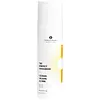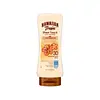What's inside
What's inside
 Key Ingredients
Key Ingredients

 Benefits
Benefits

 Concerns
Concerns

 Ingredients Side-by-side
Ingredients Side-by-side

Titanium Dioxide 6%
Cosmetic ColorantZinc Oxide 10%
Cosmetic ColorantAloe Barbadensis Leaf Juice
Skin ConditioningVitis Vinifera Seed Oil
EmollientOryza Sativa Bran Oil
EmollientGlycerin
HumectantCetearyl Olivate
Sorbitan Olivate
EmulsifyingIsoamyl Laurate
EmollientOlea Europaea Fruit Oil
MaskingGinkgo Biloba Meristem Cell
AntimicrobialCalendula Officinalis Flower
Skin ConditioningHippophae Rhamnoides Acid
EmollientCurcumin
AntioxidantCetearyl Alcohol
EmollientGlucose
HumectantLactoperoxidase
StabilisingHippophae Rhamnoides Oil
EmollientXanthan Gum
EmulsifyingMauritia Flexuosa Fruit Oil
Skin ConditioningBronzite Powder
Cosmetic ColorantCI 77492
Cosmetic ColorantPotassium Sorbate
PreservativeTapioca Starch
CI 77491
Cosmetic ColorantCI 77499
Cosmetic ColorantTitanium Dioxide 6%, Zinc Oxide 10%, Aloe Barbadensis Leaf Juice, Vitis Vinifera Seed Oil, Oryza Sativa Bran Oil, Glycerin, Cetearyl Olivate, Sorbitan Olivate, Isoamyl Laurate, Olea Europaea Fruit Oil, Ginkgo Biloba Meristem Cell, Calendula Officinalis Flower, Hippophae Rhamnoides Acid, Curcumin, Cetearyl Alcohol, Glucose, Lactoperoxidase, Hippophae Rhamnoides Oil, Xanthan Gum, Mauritia Flexuosa Fruit Oil, Bronzite Powder, CI 77492, Potassium Sorbate, Tapioca Starch, CI 77491, CI 77499
Homosalate 5.5%
Skin ConditioningEthylhexyl Salicylate 4.5%
UV AbsorberOctocrylene 4%
UV AbsorberButyl Methoxydibenzoylmethane 2%
UV AbsorberC12-15 Alkyl Benzoate
AntimicrobialCetearyl Alcohol
EmollientPhenoxyethanol
PreservativeVp/Eicosene Copolymer
Diisopropyl Adipate
EmollientNeopentyl Glycol Diheptanoate
EmollientMica
Cosmetic ColorantDimethicone
EmollientGlycerin
HumectantParfum
MaskingPolymethylsilsesquioxane
Acrylates/C10-30 Alkyl Acrylate Crosspolymer
Emulsion StabilisingCoco-Glucoside
CleansingMethylparaben
PreservativePropylene Glycol Dibenzoate
Skin ConditioningCeteth-10 Phosphate
CleansingDicetyl Phosphate
EmulsifyingPropylparaben
PreservativeSodium Hydroxide
BufferingDisodium EDTA
Paraffin
PerfumingXanthan Gum
EmulsifyingButyrospermum Parkii Butter
Skin ConditioningJojoba Alcohol
EmollientPotassium Jojobate
Skin ConditioningSimmondsia Chinensis Butter
Skin ConditioningMangifera Indica Seed Butter
Skin ConditioningPropanediol
SolventTocopheryl Acetate
AntioxidantCarica Papaya Fruit Extract
Skin ConditioningColocasia Antiquorum Root Extract
Skin ConditioningMangifera Indica Fruit Extract
Skin ConditioningPassiflora Incarnata Fruit Extract
Skin ConditioningPlumeria Acutifolia Flower Extract
Skin ConditioningPsidium Guajava Fruit Extract
AstringentPanthenol
Skin ConditioningAloe Barbadensis Leaf Juice
Skin ConditioningSodium Ascorbyl Phosphate
AntioxidantTitanium Dioxide
Cosmetic ColorantHomosalate 5.5%, Ethylhexyl Salicylate 4.5%, Octocrylene 4%, Butyl Methoxydibenzoylmethane 2%, C12-15 Alkyl Benzoate, Cetearyl Alcohol, Phenoxyethanol, Vp/Eicosene Copolymer, Diisopropyl Adipate, Neopentyl Glycol Diheptanoate, Mica, Dimethicone, Glycerin, Parfum, Polymethylsilsesquioxane, Acrylates/C10-30 Alkyl Acrylate Crosspolymer, Coco-Glucoside, Methylparaben, Propylene Glycol Dibenzoate, Ceteth-10 Phosphate, Dicetyl Phosphate, Propylparaben, Sodium Hydroxide, Disodium EDTA, Paraffin, Xanthan Gum, Butyrospermum Parkii Butter, Jojoba Alcohol, Potassium Jojobate, Simmondsia Chinensis Butter, Mangifera Indica Seed Butter, Propanediol, Tocopheryl Acetate, Carica Papaya Fruit Extract, Colocasia Antiquorum Root Extract, Mangifera Indica Fruit Extract, Passiflora Incarnata Fruit Extract, Plumeria Acutifolia Flower Extract, Psidium Guajava Fruit Extract, Panthenol, Aloe Barbadensis Leaf Juice, Sodium Ascorbyl Phosphate, Titanium Dioxide
 Reviews
Reviews

Ingredients Explained
These ingredients are found in both products.
Ingredients higher up in an ingredient list are typically present in a larger amount.
Aloe Barbadensis Leaf Juice comes from leaves of the aloe plant. Aloe Barbadensis Leaf Juice is best known for helping to soothe sunburns. It is also anti-inflammatory, moisturizing, antiseptic, and can help heal wounds.
Aloe is packed with good stuff including Vitamins A, C, and E. These vitamins are antioxidants, which help fight free-radicals and the damage they may cause. Free-radicals are molecules that may damage your skin cells, such as pollution.
Aloe Barbadensis Leaf Juice also contains sugars. These sugars come in the form of monosaccharides and polysaccharides, folic acid, and choline. These sugars are able to help bind moisture to skin.
It also contains minerals such as calcium, 12 anthraquinones, fatty acids, amino acids, and Vitamin B12.
Learn more about Aloe Barbadensis Leaf JuiceCetearyl alcohol is a mixture of two fatty alcohols: cetyl alcohol and stearyl alcohol. It is mainly used as an emulsifier. Emulsifiers help prevent the separation of oils and products. Due to its composition, it can also be used to thicken a product or help create foam.
Cetearyl alcohol is an emollient. Emollients help soothe and hydrate the skin by trapping moisture.
Studies show Cetearyl alcohol is non-toxic and non-irritating. The FDA allows products labeled "alcohol-free" to have fatty alcohols.
This ingredient is usually derived from plant oils such as palm, vegetable, or coconut oils. There is debate on whether this ingredient will cause acne.
Due to the fatty acid base, this ingredient may not be Malassezia folliculitis safe.
Learn more about Cetearyl AlcoholGlycerin is already naturally found in your skin. It helps moisturize and protect your skin.
A study from 2016 found glycerin to be more effective as a humectant than AHAs and hyaluronic acid.
As a humectant, it helps the skin stay hydrated by pulling moisture to your skin. The low molecular weight of glycerin allows it to pull moisture into the deeper layers of your skin.
Hydrated skin improves your skin barrier; Your skin barrier helps protect against irritants and bacteria.
Glycerin has also been found to have antimicrobial and antiviral properties. Due to these properties, glycerin is often used in wound and burn treatments.
In cosmetics, glycerin is usually derived from plants such as soybean or palm. However, it can also be sourced from animals, such as tallow or animal fat.
This ingredient is organic, colorless, odorless, and non-toxic.
Glycerin is the name for this ingredient in American English. British English uses Glycerol/Glycerine.
Learn more about GlycerinTitanium dioxide is a mineral UV filter widely used in sunscreens and cosmetics.
It is one of only two UV filters officially classified as “mineral” by regulatory agencies, the other being zinc oxide.
Titanium dioxide provides broad-spectrum protection mostly in the UVB and UVAII range, with some protection in the UVAI range.
While its UVA protection isn’t as strong as zinc oxide’s, the difference is minor.
A common myth is that mineral UV filters reflect UV light. However, modern research shows titanium dioxide absorbs UV radiation like chemical filters (~95% absorption & 5% reflection).
Thanks to its non-irritating nature, titanium dioxide is suitable for sensitive, acne-prone, or redness-prone skin. It is unlikely to cause "eye sting" like other sunscreen ingredients.
A major drawback of this ingredient is its white cast and thick texture. This is why mineral sunscreens often leave a white cast and are less cosmetically elegant than chemical/hybrid sunscreens.
To improve white cast and spreadability, micronized or nano-sized titanium dioxide is often used.
There are ongoing concerns surrounding nano-titanium oxide's impact on marine ecosystems.
There is no conclusive evidence that any form of titanium oxide (or any other sunscreen ingredients) will cause harm to marine ecosystems or coral reefs. The science is still developing but many consumers are keeping a close eye on this issue.
Please note, many destinations have reef-safety sunscreen rules. For instance, the U.S. Virgin Islands advises all visitors to use non-nano mineral sunscreens.
Nano mineral sunscreens once raised safety concerns about absorption into skin.
Extensive research has shown that they do not penetrate healthy or damaged skin; they remain safely on the surface and the top layer of dead skin (stratum corneum).
You'll likely find titanium dioxide bundled with alumina, silica, or dimethicone. These ingredients help make titanium dioxide highly photostable; this prevents it from interacting with other formula components under UV light.
Learn more about Titanium DioxideXanthan gum is used as a stabilizer and thickener within cosmetic products. It helps give products a sticky, thick feeling - preventing them from being too runny.
On the technical side of things, xanthan gum is a polysaccharide - a combination consisting of multiple sugar molecules bonded together.
Xanthan gum is a pretty common and great ingredient. It is a natural, non-toxic, non-irritating ingredient that is also commonly used in food products.
Learn more about Xanthan Gum